By Grif Ingram, Papers and Archivist Assistant
There are many space attractions in the UK that offer a great experience for families.
It is strongly recommended that you check with each venue as to current opening conditions, such as opening times, and whether advance booking is required, before setting out.
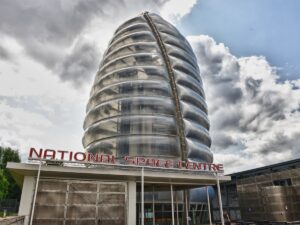
The National Space Centre, at Exploration Drive, Leicester, LE4 5NS, offers a host of fascinating exhibits, including a Soyuz spacecraft, a display of spacesuits (including the BIS Moon Suit), and the acceleration couch used by Britain’s first astronaut, Helen Sharman, with Blue Streak and Thor missiles in the iconic Rocket Tower. The NSC will be open from 22nd May, and booking in advance is essential.
Take a look at the website for the National Space Centre at https://collections.spacecentre.co.uk/home. The NSC makes a big effort to enable disabled access, details of which can be found at https://spacecentre.co.uk/wp-content/uploads/2019/04/NSC_Access_Statement_-_March_2019.docx. Nearest station: Leicester, No 54 bus from Charles Street, near to station.
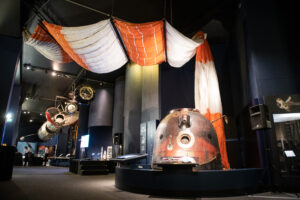
The Science Museum, in Exhibition Road, South Kensington, London, SW7 2DD, has a Space Galllery, with a full-size mock-up of the Apollo 11 Eagle Lunar Module in which Armstrong and Aldrin landed on the Moon, and with two rockets, an American Scout and a British Black Arrow, hanging from the ceiling. There is a display about the British Skylark rocket, which was assembled with the help of BIS Fellow Robin Brand, and a model of the cabin of the post-War BIS Moonship, built by BIS member N R Nicoll. Also on display is the Soyuz capsule in which British astronaut Tim Peake travelled to the International Space Station.
Further information about the Science Museum, including access information, booking, and travel details, is available at: https://www.sciencemuseum.org.uk/see-and-do/welcome-back. Nearest Tube: South Kensington.
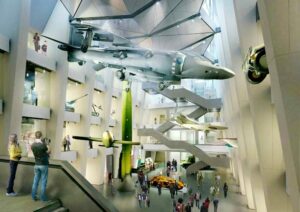
The Imperial War Museum, located in Lambeth Road. London, SE1 6HZ, has a number of items of astronautical interest, such as a 40% aerodynamic test model of the Blue Steel stand-off missile, a weapon system designed to enable the V-bombers of the Royal Air Force to deliver nuclear bombs to their targets – one of the two rocket motors propelling these missiles was developed into the “Gamma” rocket engines that powered Black Knight and Black Arrow. The most spectacular item, however, is the complete German V-2 missile, stood on its tail next to the balconies, with portions of the skin removed to enable you to see interior detail. This remarkable missile was, in many ways, the forerunner of the large rocket vehicles of the “Space Race” era, despite the fact that it rained down death on London in the last months of the Second World War.
Website: https://www.iwm.org.uk/visits/iwm-london. Nearest Tube: Lambeth North.
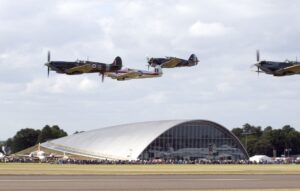
IWM Duxford, the Duxford branch of the Imperial War Museum (Duxford Airfield, Building 425, Cambridge CB22 4QR) has an actual example of a Blue Steel, an impressive 10.7 metres long, and also has an example of the Vulcan bomber from which it was launched. The missile used hydrogen peroxide as an oxidiser; a mere splash on one’s clothing could start a fire. After flying exercises with a fully-fuelled missile, it was the job of the navigator to don a protective suit (with insufficiently long sleeves!) and unload the hydrogen peroxide – which must have been far from their favourite part of the flight!
Website: https://www.iwm.org.uk/visits/iwm-duxford. Nearest railway stations: Whittlesford Parkway, Royston, and Cambridge.
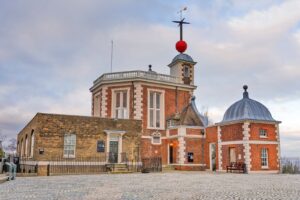
The Royal Observatory Greenwich, on Blackheath Ave, Greenwich, London SE10 8XJ, has too many interesting items to list! The Prime Meridian, from whence the whole world takes its time, is outside the Observatory, in a courtyard with breathtaking views of London.
Inside are such fascinating exhibits as the Harrison clocks, which enabled ships to determine their longitude for the first time, and the Great Equatorial Telescope. The Chronometer House contains a collection of beautiful instruments, which were vital for accurate navigation; all ship’s captains used to visit Greenwich before departure to synchronise their chronometers. The John Harrison Planetarium is now the only one in London, offering a variety of spectacular shows. The design of the Planetarium building is of interest in itself; the building is in the shape of a cone, with the north side lined up with the zenith (straight up) at Greenwich, and the south side, which slopes, pointing towards the Pole star, Polaris. The angle of slope of the cone is parallel to the celestial equator, and the whole planetarium is lined up with the north-south line. Should you wish to take refreshment, the Astronomy Café & Terrace is open on weekends and school holidays to Planetarium ticket holders; the Terrace offers superb views of Greenwich Park, and outside the café, on Gagarin Terrace, is a statue of Yuri Gagarin, unveiled in 2013 by his daughter, Elena Gagarina, and presented by the Russian federal space agency, Roscosmos, to the British people.
Learn more about The Royal Observatory Greenwich at: https://www.rmg.co.uk/royal-observatory. Nearest stations: Greenwich Station, Cutty Sark DLR, and Maze Hill Station.

The RAF Museum Cosford, at Shifnal, Shropshire, TF11 8UP, has an example of a Thor Intermediate Range Ballistic Missile (IRBM), a weapon deployed in Britain under “dual key” RAF/USAF control from 1959 to 1963. The missile was later developed into a satellite launching vehicle, as the Thor-Ablestar, Thor-Agena, and Thor-Delta.
Details about the RAF Museum Cosford can be found at: https://www.rafmuseum.org.uk/cosford. Nearest station: Cosford.
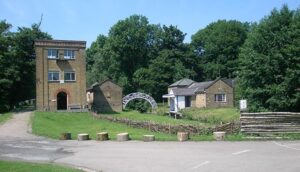 The Royal Gunpowder Mills, Beaulieu Drive, Waltham Abbey, Essex, EN9 1JY, has many exhibits of interest to the space enthusiast in their Rocket Vault, including the two-chamber Stentor rocket motor that powered the Blue Steel missile, the smaller chamber of which was developed into the Gamma engine used on the Black Knight and Black Arrow rockets. An example of the Waxwing solid motor that propelled the third stage of Black Arrow, which used a unique solid propellant developed at the Royal Gunpowder Mills when the site was a working establishment.
The Royal Gunpowder Mills, Beaulieu Drive, Waltham Abbey, Essex, EN9 1JY, has many exhibits of interest to the space enthusiast in their Rocket Vault, including the two-chamber Stentor rocket motor that powered the Blue Steel missile, the smaller chamber of which was developed into the Gamma engine used on the Black Knight and Black Arrow rockets. An example of the Waxwing solid motor that propelled the third stage of Black Arrow, which used a unique solid propellant developed at the Royal Gunpowder Mills when the site was a working establishment.
The Royal Gunpowder Mills is currently open only for outdoor visits, on Sundays and Bank Holidays from 10 am to 3pm, until September. After July, with the end of Covid-related restrictions, the indoor collections will re-open.
Learn about the Royal Gunpowder Mills at: https://www.royalgunpowdermills.com/. Nearest Station: Waltham Cross (Greater Anglia) Tube: Loughton (Central Line) followed by 66 bus towards Debden.





